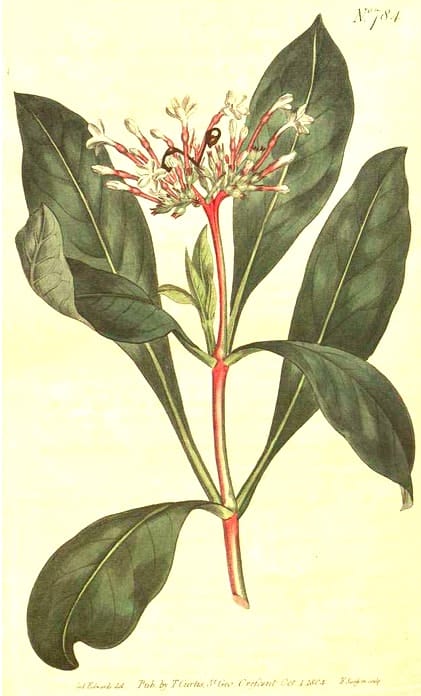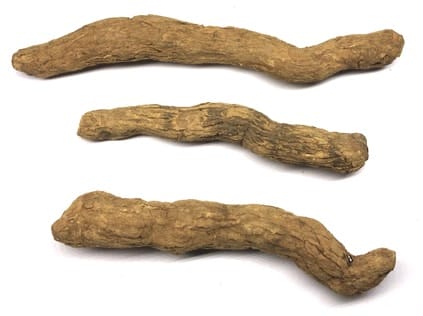Rauwolfia, SarpagandhaSnake rootSarpagandha (Ayurveda.) Asrol, Choti-Chandan (Unani) Bai Hua Lian, Shan Ma Ti (TCM) |

|

|

 Rauwolfia serpentina
Rauwolfia serpentinaCurtis’s Botanical Magazine, 1804
 Rauwolfia root
Rauwolfia root(Calcutta Unani College, Adam, 2019)
Botanical name:
Rauwolfia serpentina
other species used in India include R. beddomei, R. densiflora, R. micrantha;
R. tetraphylla (syn. R. canescens) is also used but is low enough in alkaloids to be considered an adulterant
in China R. verticillatae is used.
Parts used:
Root
Temperature & Taste:
Cold, dry. Bitter, Poison
Classifications:
3J. INCREASE SEMEN
I. Medicines for Internal Wind
Uses:
1. Calms Internal Wind:
-Headache, Vertigo, Dizziness, Tinnitus, Restlessness and Insomnia etc.
-especially used for Hypertension.
-reduces Heart rate
2. Settles Wind, Clears Heat, Calms the Mind, Treats Insanity:
-Restlessness, Insomnia, Irritability, Stress, Anxiety
-long history of use in India for Violent Mania, Insanity, Psychosis, Neuropsychiatric disorders
-highly regarded for Schizophrenia.
-Mania, with restlessness and aggression, but not effective for those withdrawn, depressed and Melancholic.
-especially for Insanity with Hypertension, or Liver Yang types.
-also recommended for Mental Retardation
3. Clears Wind-Heat, Resists Poison:
-Cold, Flu, Sore Throat
-Boils, Carbuncles, Eczema, Skin lesions
-Fever, Spotted Fevers including Measles
-Snake Bites and the stings of poisonous Insects, Scorpions etc.
4. Clears Stomach Heat, Eases Pain:
-Abdominal Pain, Vomiting, Diarrhea.
5. Moves the Blood:
-Dysmenorrhea (said to be very effective)
-Promotes Uterine Contractions, promotes expulsion the Fetus. (Decoction)
6. Benefits Kidneys, Increases Semen
-Traditionally said to increase Semen (long-term use was said to cause sterility however)
-also used for Diabetes
Dose:
1. In the treatment of Insanity and Mania, 20 grain doses taken twice daily for a week usually restores the senses, although longer treatment may be required. Powder has been taken with Rose water for Mania and the Mentally retarded.
2. In the treatment of Hypertension, long term use of low doses is safe and effective. It should be combined with a diuretic.
3. In long-term therapy for Hypertension, Blood diseases or Mental diseases, low doses are used.
4. Larger doses produce deep sleep and are only suitable for short-term use.
5. In classical Ayurveda, the root was often chewed to achieve therapeutic effect.
POWDER: 250–600mg, up to 1200mg twice daily as a sedative and anti-hypertensive;
DECOCTION: 3–12 grams (rarely up to 30 grams in China).
Correctives:
1. Delphinium denudatum (Unani)
2. Black Pepper (Unani)
Substitutes:
1. Valerian as Anti-Hypertensive
2. Valerian or Indian Spikenard as a Cardiac tonic. (Unani)
Comment:
Rauwolfia has been used for Hypertension; its alkaloid reserpine was one of the early anti-hypertensive medicines used in modern medicine. It has a (supposedly) long history of use for mania and insanity. However Khare (Indian Herbal Remedies) states that Rauwolfia was not classically used in Ayurveda and that the classical Sarpaganda was another herb. Nevertheless, it has been found useful for mental illness, psychosis and schizophrenia in recent times.
Main Combinations:
1. Fever, Rauwolfia with Andrographis
2. Sore Throat, Rauwolfia with Isatis Folium Da Qing Ye, Belamcanda She Gan (TCM)
3. Insomnia:
i. Rauwolfia with Indian Spikenard and Tinospora cordifolia.
ii. Rauwolfia, Henbane seed, Cannabis leaf, Indian Spikenard
4. To induce rest and sleep, for irritability and insanity, and for Hypertension, Rauwolfia with Henbane, Cannabis, Indian Spikenard (as in Rauwolfia Tablets [Sarpagandha Ghanavati] of Ayurveda)
5. Nervous conditions, Rauwolfia with Indian Spikenard, Centella, Licorice
6. Melancholy, Epilepsy, Hysteria, Insomnia, Hypersensitivity, Rauwolfia in pills with Black Pepper (which is its corrector)
7. Mental diseases:
i. Rauwolfia with Calamus
ii. Rauwolfia with Centella, Withania, Calamus
iii. Rauwolfia with Withania, Centella, Indian Spikenard
8. Hypertension:
i. Rauwolfia with Arjuna, Cardamon, Rose
ii. with excitability and mental disoorder, Rauwolfia with Withania, Centella, Indian Spikenard
iii. Rauwolfia with Gastrodia Tian Ma, Uncaria Gou Teng, Self Heal (Xia Ku Cao), Siegesbeckia Xi Xian Cao (TCM)
9. Diabetes, Rauwolfia with Red Sandalwood, Andrographis
10. Snake Bite, crush the leaves and apply topically.
Major Formulas:
Sarpagandha Ghana Vati
Cautions:
1. Large doses produce deep sleep and diminished sense of pain.
2. Not used in Pregnancy or while Breast feeding (potentially abortifacient).
3. Contraindicated in Depression, Bleeding disorders, weak digestion, Gastro-duodenal Ulcers, Ulcerative Colitis or Qi and Blood deficiency.
4. Fluid retention may result from the use of Rauwolfia.
5. In India it is believed long-term use results in Sterility; some sources say this occurs after 10 years of use.
Toxicity
1. Side effects from overdose may include gastrointestinal distress, nausea, vomiting, diarrhea, loss of appetite, drowsiness, convulsions, tremors and coma. Overdose may cause death from respiratory depression.
2. Detrimental effects on Kidney tissue have been shown (see here)
Drug Interactions:
1. Not used with Digoxin or Digitalis-based medicines.
Main Preparations used:
|
‘This shrub is mentioned in Sanskrit works under the names of Sarpagandha and Chandrika. The Hindus use the root as a febrifuge, and as an antidote to the bites of poisonous reptiles, also in dysentery and other painful affections of the intestinal canal. By some it is supposed to cause uterine contraction and promote the expulsion of the foetus. Ainslie gives the following account of it:— Tsjovanna amelpodi is the name given, on the Malabar Coast (Rheede, Mai. vi. 8], t. 47), to a plant, the bitter root of which is supposed to have sovereign virtues in cases of snake-bites and scorpion-stings; it is ordered in decoction, to the extent of a pint in twenty-four hours, and the powder is applied, externally, to the injured part. The plant is the Radix mustela of Rumphius. (Arab. vii. 29, t. 16.) The Javanese class it among their anthelmintics, and give it the name of pulipandak. It may be found noticed both by Burman in his Thesaur. Zeylan. (t. 64) and Garcia ab Horto; the latter recommends it as stomachic; Rumphius speaks of it as an antidote to poisons. |
It will be seen that Ainslie confounds it with the Radix mustela or ichneumon root (Ophiorrhiza Mungos), and the natives of some other parts of India appear to make the same mistake. Sir W. Jones (Asiat. Research, iv., p. 308,) thinks it possible that this plant may perhaps be the true ichneumon plant. In the Pharmacopoeia of India its use in labours to increase uterine contractions is noticed upon the authority of Dr. Pulney Andy, but we have no other evidence of its efficacy in such cases. In Bombay most of the labourers who come from the Concan keep a small supply of the root, which they value as a remedy in painful affections of the bowels. In the Concan the root with Aristolochia indica (Sapsan) is given in cholera; in colic 1 part of the root with 2 parts of Holarrhena root and 3 parts of Jatropha Curcas root is given in milk; in fever the root with Andragraphis paniculata, ginger and black salt is used. The dose of the combined drugs in each case is from 3 to 4 tolas. (Pharmacographia Indica, Dymock, 1891) |
